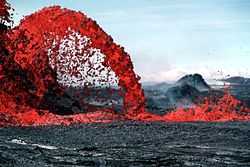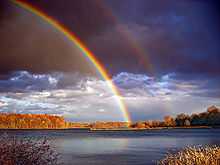Natural phenomenon
A natural phenomenon is not a man-made event.They may be too dangerous and may even led to death Examples include sunrise, weather (fog, hurricanes, tornadoes), biological processes (decomposition, germination), physical processes (wave propagation, conservation of energy, erosion), tidal flow, and include natural disasters such as electromagnetic pulses, volcanic eruptions, earthquakes.[1][2]
Various types of natural phenomena occur, including (but not limited to) the following:
- Geological phenomena (volcanic activity and earthquakes)
- Meteorological phenomena (hurricanes, thunderstorms, and tornadoes)
- Oceanographic phenomena (tsunamis, ocean currents and breaking waves)
Exposure to forces of nature resulted in about 214,000 deaths in 2010 up from 31,000 in 1990.[3]
Gallery
-

An aurora is a natural phenomenon.
-

Lightning strikes during the eruption of the Galunggung volcano in 1982.
-

This parabola-shaped lava flow illustrates Galileo's law of falling bodies, as well as blackbody radiation. The temperature can be discerned from the color of the blackbody.
-

A double rainbow at Minsi Lake, Pennsylvania.
See also
References
- ↑ Missy Allen; Michel Peissel (1993). Dangerous natural phenomena. Chelsea House. ISBN 079101794X.
- ↑ William R. Corliss (1977). Handbook of unusual natural phenomena. Sourcebook Project. ISBN 0915554011.
- ↑ Lozano, R (Dec 15, 2012). "Global and regional mortality from 235 causes of death for 20 age groups in 1990 and 2010: a systematic analysis for the Global Burden of Disease Study 2010.". Lancet 380 (9859): 2095–128. PMID 23245604.